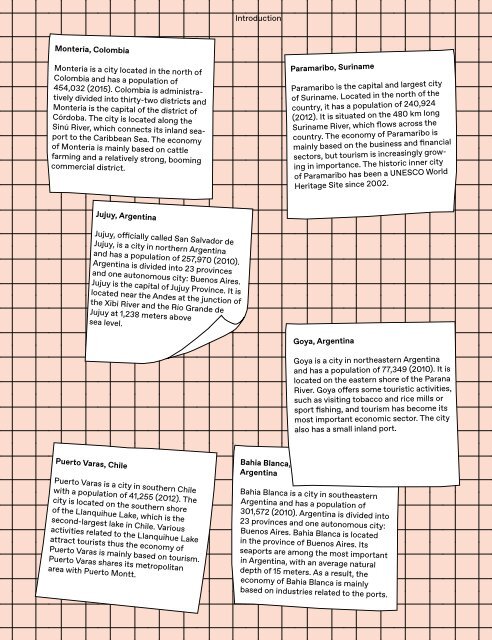Urban Design Lab Handbook – Dialogue-oriented urban transformation processes and practical approaches from Latin America and the Caribbean
ISBN 978-3-86859-562-8 https://www.jovis.de/en/books/preview/product/urban-design-lab-handbook.html
ISBN 978-3-86859-562-8
https://www.jovis.de/en/books/preview/product/urban-design-lab-handbook.html
Create successful ePaper yourself
Turn your PDF publications into a flip-book with our unique Google optimized e-Paper software.
Introduction<br />
Monteria, Colombia<br />
Monteria is a city located in <strong>the</strong> north of<br />
Colombia <strong>and</strong> has a population of<br />
454,032 (2015). Colombia is administratively<br />
divided into thirty-two districts <strong>and</strong><br />
Monteria is <strong>the</strong> capital of <strong>the</strong> district of<br />
Córdoba. The city is located along <strong>the</strong><br />
Sinú River, which connects its inl<strong>and</strong> seaport<br />
to <strong>the</strong> <strong>Caribbean</strong> Sea. The economy<br />
of Monteria is mainly based on cattle<br />
farming <strong>and</strong> a relatively strong, booming<br />
commercial district.<br />
Paramaribo, Suriname<br />
Paramaribo is <strong>the</strong> capital <strong>and</strong> largest city<br />
of Suriname. Located in <strong>the</strong> north of <strong>the</strong><br />
country, it has a population of 240,924<br />
(2012). It is situated on <strong>the</strong> 480 km long<br />
Suriname River, which flows across <strong>the</strong><br />
country. The economy of Paramaribo is<br />
mainly based on <strong>the</strong> business <strong>and</strong> financial<br />
sectors, but tourism is increasingly growing<br />
in importance. The historic inner city<br />
of Paramaribo has been a UNESCO World<br />
Heritage Site since 2002.<br />
Jujuy, Argentina<br />
Jujuy, officially called San Salvador de<br />
Jujuy, is a city in nor<strong>the</strong>rn Argentina<br />
<strong>and</strong> has a population of 257,970 (2010).<br />
Argentina is divided into 23 provinces<br />
<strong>and</strong> one autonomous city: Buenos Aires.<br />
Jujuy is <strong>the</strong> capital of Jujuy Province. It is<br />
located near <strong>the</strong> Andes at <strong>the</strong> junction of<br />
<strong>the</strong> Xibi River <strong>and</strong> <strong>the</strong> Río Gr<strong>and</strong>e de<br />
Jujuy at 1,238 meters above<br />
sea level.<br />
Goya, Argentina<br />
Goya is a city in nor<strong>the</strong>astern Argentina<br />
<strong>and</strong> has a population of 77,349 (2010). It is<br />
located on <strong>the</strong> eastern shore of <strong>the</strong> Parana<br />
River. Goya offers some touristic activities,<br />
such as visiting tobacco <strong>and</strong> rice mills or<br />
sport fishing, <strong>and</strong> tourism has become its<br />
most important economic sector. The city<br />
also has a small inl<strong>and</strong> port.<br />
Puerto Varas, Chile<br />
Puerto Varas is a city in sou<strong>the</strong>rn Chile<br />
with a population of 41,255 (2012). The<br />
city is located on <strong>the</strong> sou<strong>the</strong>rn shore<br />
of <strong>the</strong> Llanquihue Lake, which is <strong>the</strong><br />
second-largest lake in Chile. Various<br />
activities related to <strong>the</strong> Llanquihue Lake<br />
attract tourists thus <strong>the</strong> economy of<br />
Puerto Varas is mainly based on tourism.<br />
Puerto Varas shares its metropolitan<br />
area with Puerto Montt.<br />
Bahia Blanca,<br />
Argentina<br />
Bahia Blanca is a city in sou<strong>the</strong>astern<br />
Argentina <strong>and</strong> has a population of<br />
301,572 (2010). Argentina is divided into<br />
23 provinces <strong>and</strong> one autonomous city:<br />
Buenos Aires. Bahia Blanca is located<br />
in <strong>the</strong> province of Buenos Aires. Its<br />
seaports are among <strong>the</strong> most important<br />
in Argentina, with an average natural<br />
depth of 15 meters. As a result, <strong>the</strong><br />
economy of Bahia Blanca is mainly<br />
based on industries related to <strong>the</strong> ports.


















